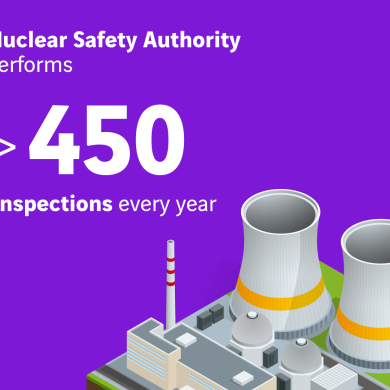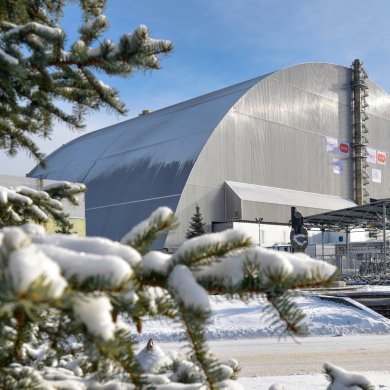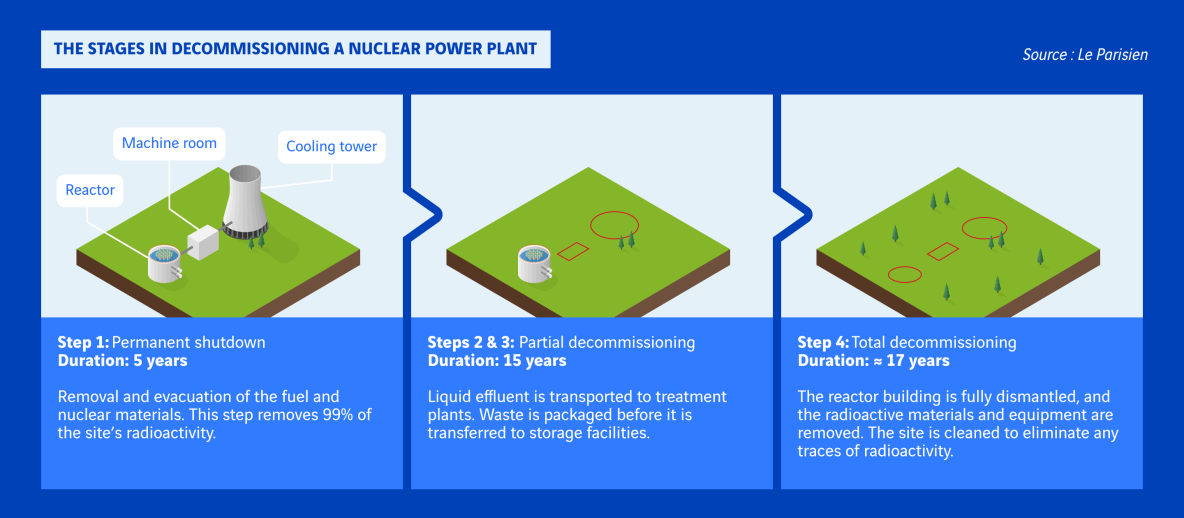
Challenges and discussions about nuclear power
Discussions about nuclear power plants tend to revolve around two topics, namely how to manage the industrial risk and how to deal with nuclear waste. Read on for an explanation.
On the same focus
The groundbreaking civil nuclear fission sector
France, the land of nuclear power
Fusion: the energy creating high hopes
Keeping nuclear power plants safe
Nuclear power plant safety: the defence in depth principle
A nuclear reactor features a series of independent and successive defences. These safety systems are incorporated, doubled and even tripled during the plant’s construction and are continually improved while the plant is in operation. The three main safety barriers that underlie the defence-in-depth approach include:
- the fuel rod cladding, which is a sealed tube surrounding the uranium pellets.
- the primary circuit containment, which maintains the integrity of the cooling circuit for the fuel rods.
- the containment building, which is engineered from reinforced concrete and massively strengthened with prestressing tendons to withstand the extreme mechanical pressure.
Freyssinet, a VINCI Construction subsidiary, has actually built the containment buildings for 58 French nuclear reactors.

In France, nuclear power plants can only be commissioned and operated with approval from the ASN (Nuclear Safety Authority). The ASN’s inspectors carry out over 450 scheduled inspections and spot checks every year. In the United States, supervisory duties fall to the Nuclear Regulatory Commission (NRC), while that role is held by the National Nuclear Safety Authority (NNSA) in China. Every country has set up an authority to ensure safety at its nuclear power plants. Facilities are regularly assessed by the International Atomic Energy Agency (IAEA), which was created in 1957 when the civil nuclear industry was still in its teething stages. The IAEA is also responsible for disseminating international best practices.
Reactions, actions and adaptations
Many risk factors have very little chance of causing a disaster on their own, but it is a different story when those risks start stacking up. Accidents can also happen when mistakes keep building up in the long term, especially if combined with an outage, as well as when external risks are downplayed or exceptional events occur. However rare and devastating previous accidents might have been, they have nevertheless been instrumental in improving safety standards.
New post-Fukushima regulations
In the aftermath of the Fukushima accident in Japan in 2011, major efforts were made around the world to make nuclear power plants even safer. In France, the ASN asked EDF to take a serie of "hard-core post-Fukushima" measures such as building crisis management bunkers and installing emergency diesel backup generators.

The Chernobyl New Safe Confinement
In 2019, VINCI and its partners handed over the key to the new safe confinement to the Ukrainian authorities for the damaged reactor no. 4 at the Chernobyl power plant after an extraordinary construction effort spanning 12 years. The arch is the largest moveable land-based structure ever built. It is designed to make the accident site safe for 100 years and allow the damaged reactor to be dismantled and the radioactive waste to be treated.
Nuclear waste: deciding between recycling and burial
Unlike fossil fuels, nuclear power produces clean electricity that generates few very greenhouse gas emissions. However, the waste generated (especially radioactive waste) represents one of the main challenges facing the nuclear industry. Like other countries with a high number of civil nuclear power plants, France has built the necessary infrastructures to manage, treat and recover nuclear waste.
In La Hague in north-western France, Vinci has a dedicated centre for reprocessing spent nuclear fuel from reactors across France and Europe. When nuclear fuel is removed from the reactor, it is contaminated. The recoverable plutonium and uranium need to be separated from the spent fuel, while the long-lived high-level waste (LL-HLW) is treated and stored. The centre has undergone a number of upgrades since it was first opened in 1966. In 2019, Orano awarded a contract to VINCI Construction subsidiary Nuvia to provide specialised maintenance services for 600 devices with the aim of guaranteeing safety at its facilities. Omexom teams (VINCI Energies), also carried out work to increase the capacity of the industrial units on site.
The Melox plant in Marcoule in southern France is the only nuclear facility in France with the capacity to recycle part of the plutonium from spent fuel to create MOX fuel (mixed oxide). The MOX is used in 22 of France’s 58 reactors. The teams are also examining the prospect of multi-recycling the plutonium in spent MOX.
Finally, several near-surface disposal centres are used to store non-recoverable final radioactive waste. CDB (Conditionnement Déchets Béton), a joint venture between VINCI Construction and Cyclife France (EDF Group), manufactures reinforced concrete containers for the radioactive waste generated by in-service nuclear power plants. In France, there is currently only one project for building a deep geological disposal facility for radioactive waste. The project, called Cigéo (industrial centre for geological disposal), is being spearheaded by Andra (French agency for the management of radioactive waste). On this project, Cegelec CEM (VINCI Energies) carried out 200,000 hours of engineering studies on subsystems to handle and store packages of long-life waste.
End of life nuclear power plants
Strict procedures must be followed when decommissioning a site to prevent any contamination. The time taken to decommission a site is estimated at 30 years, from permanently shutting down the reactor to removing the waste, demolishing the buildings and restoring the site to its initial state. VINCI Construction subsidiary Nuvia has carried out a wide range of complex decommissioning operations across France and Europe, including studies, waste management, building demolition and site decontamination.
Sources :
Most viewed
Vous aimerez aussi
Words from researchers: let's fight stereotypes!
Charlotte, a research fellow at École des Mines, and Erwan, a university professor and researcher at AgroParisTech, talk…
Fondation VINCI pour la Cité: opening the door to others is another way of reaching out!
With some 1.3 million organisations and 2 million employees, France can lay claim to a dynamic network of associations…
Sea water desalination: a solution for turning the tide on the water scarcity crisis?
As water shortages continue causing havoc in a growing number of regions around the world, an age-old idea is experiencing a…





